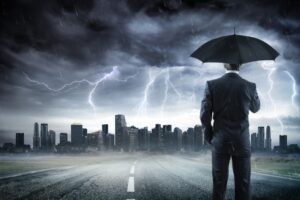Why Your Natural Disaster Insurance May Not Be as Watertight as You Think
You had a quick glance at your building insurance policy and saw that the words storm, earthquake, and flood were mentioned — so automatically assumed you’re covered with all-event natural disaster insurance.
Unfortunately, that’s often not true.
In Australia, the natural disaster cover provided by commercial properties insurance varies significantly from policy to policy. Not just in the events they safeguard against, but also in the value of the cover limits.
Meaning, you could be under-protected, overexposed, and risking the very existence of your enterprise.
This is your complete exposé of insurance for natural disasters — revealing the surprising truth behind cover, and how to ensure your operation is sufficiently defended.
What Does Insurance Cover in Natural Disasters?
Australia enjoys — or perhaps more accurately endures — more than its fair share of natural disasters. From earthquakes and tropical storms to floods and bushfires, it often seems your business premises are constantly under threat.
But, while you can’t predict or prevent what Mother Nature will do next, you can ensure your building insurance for commercial property is sufficiently comprehensive to tackle unexpected and unwanted events.
However, what you think is covered, and what the policy actually states is protected, can be surprisingly different.
Bushfires
From July 2019 through to February 2020, Australia suffered its worst-ever bushfire season — causing around $80 billion in property and economic damage. It’s just a short matter of time until that unwanted record number is passed.
Generally speaking, bushfires are insured as natural disasters in building policies under standard fire cover. That said, some schedules require bushfires to be addressed as an optional extra — so check your policy now!
Furthermore, there are often a couple of bushfire exclusions to watch out for:
- Proximity to your premises — cover may only include fires that occur within 100 metres of your building, irrespective of whether the fire causes scorch, smoke, or melt damage from a greater distance.
- Waiting period — typically, your cover is void if you claim for losses experienced within 48-72 hours of purchasing the policy. Therefore, you can’t take out protection as soon as you see fires closing in.
Cyclones and Storms
Storm cover generally addresses all severe weather conditions that lead to damage — such as cyclones, hail, lightning strikes, and snow.
As typically broad cover, it can safeguard commercial property damage such as;
- Damage to your property roof or windows caused by hail or sitting snow.
- Damage to your building or your property contents through stormwater.
- Weather that causes tree trunks or limbs to break, leading to impact that results in property damage.
- Lightning strikes that lead to fires, scorching, or electrical damage to wiring or equipment.
- Damage to your building from cyclones — particularly important if your business is in the north of Western Australia, Queensland, and the Northern Territory.
Check your business insurance policy, as it will often not cover:
- Damage caused by stormwater once it hits the ground — if it is included, it’s usually referred to as run-off.
- Storm damage to lawns, exterior plants, and external paint.
Ground Movement and Landslides
As a rule of thumb, ground movement isn’t included in natural disaster insurance — whether landslides, subsidence, or erosion.
Therefore, if you’re lucky enough to have business premises near the ocean, and the area is prone to landslides or wearing away of the cliff face — you will not be able to make a claim if your offices drop into the watery depths.
In your commercial building insurance policy, this exclusion is usually described as actions of the sea. That said, it’s possible to have a bespoke policy that protects against ground movement — but naturally, this tailored safeguarding will cost your business additional expense on top of its standard building insurance.
Tsunamis, Volcanic Eruptions, and Earthquakes
While the risks of tsunamis, earthquakes, hydrothermal activity, and volcanic eruptions are luckily rare in Australia — they can still occur. As recently as 2021, Victoria was awoken to a six-magnitude earthquake, and volcanic ash often drifts across to the Northern and Eastern Coast from the Ring of Fire.
Cover is usually included in standard business property insurance — safeguarding both your bricks and mortar and contents to the sum insured.
Floods
Most business owners believe that flood cover is included as standard in commercial property insurance, or addressed under storm cover. Unfortunately, that’s seldom the case.
Since 2017, a flood has been defined by insurers as water that escapes from a reservoir, lake, creek, canal, dam, or river — and should this floodwater penetrate and damage your premises and contents, you’re typically unprotected.
Therefore, if your enterprise is located near a water source, in a location prone to flooding, or in a low-lying area — it’s worthwhile considering additional flood protection insurance.
How To Protect Your Business Against Natural Disasters
Natural disasters are inevitable. And, while you may have commercial insurance in place, it’s unlikely to cover the total extent of damage and losses your business may experience in the event of a claim.
Therefore, taking a proactive approach can reduce the impact that natural disasters have on your operation — including reducing costly downtime:
Protecting your business against fires:
- Keep the inside and outside of your business free from flammable materials, including paper and cardboard waste.
- Ensure your smoke alarms, fire alarms, and sprinklers are tested according to your schedule.
- Regularly inspect and maintain your mains wiring system and circuit breakers.
- Maintain fire extinguishers and train employees in their use.
- Run frequent fire drills — even if you have a small business premises with few employees.
- Ensure staff smoking areas are located at a significant distance from your main business premises.
Protecting your business against floods and storms:
- Check, maintain, and clean gutters, drains, and downpipes.
- Conduct a risk assessment to examine areas of your building likely to flood.
- Install raised entrances to prevent stormwater and floodwater ingress.
- Store business files and documents in waterproof boxes — or use solely cloud-based systems.
- Keep electrical equipment elevated off the floor.
- Wherever possible, have high-level electrical power points.
- Inspect and repair your business premises’ roofs regularly.
- Secure outdoor items in storm season — such as barriers, signage, and advertising boards.
Protecting against earthquakes:
- Don’t hang heavy boards, signs, screens, or televisions near sitting or public areas.
- Secure shelving, decorative lighting, and suspended ceilings.
- Fit emergency lighting and backup generators.
- Install seismic shut-off valves to safeguard against water and gas leaks.
- Have a structural assessment of your business premises.
- Rehearse drop, cover, and hold scenarios with your staff.
Don’t Assume You’re Protected — Check Your Business Insurance Today
Having commercial building insurance doesn’t mean you’re defended against all natural disasters — so check your policy today!
At PIB, we can perform a comprehensive risk assessment to ascertain the areas of risk inherent to your operation — and ensure you have cover that addresses your enterprise’s particular threats.
Leaving it until it’s too late could be costly and business-threatening — call us today to discuss watertight natural disaster insurance.






